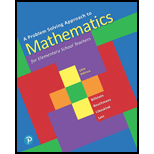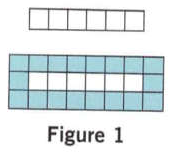
Concept explainers
NOW TRY THIS
Noah has some white square tiles and some blue square tiles. They are all the same size. He first makes a row of white tiles and then surrounds the white tiles with a single layer of blue tiles, as shown in Figure

How many blue tiles does he need:
a. to surround a row of
b. to surround a row of
(a)
To find:
Number of blue tiles needed to surround hundred white tiles by a single layer of blue tiles.
Answer to Problem 1NT
Solution:
Number of blue tiles needed to surround hundred white tiles is
Explanation of Solution
Given:
All tiles are of same size. A row of white tiles is surrounded by a single layer of blue tiles.
Approach:
Number of blue tiles needed will be sum of two times number of white tiles and six tiles on the sides.
Calculation:
Number of white tiles
Number of blue tiles needed to surround hundred white tiles,
Hence,
(b)
To find:
Number of blue tiles needed to surround n white tiles by a single layer of blue tiles.
Answer to Problem 1NT
Solution:
Number of blue tiles needed to surround hundred white tiles is
Explanation of Solution
Given:
All tiles are of same size. A row of white tiles is surrounded by a single layer of blue tiles.
Approach:
Number of blue tiles needed will be sum of two times number of white tiles and six tiles on the sides.
Calculation:
Number of white tiles
Number of blue tiles needed to surround n white tiles,
Hence,
Want to see more full solutions like this?
Chapter 8 Solutions
EBK A PROBLEM SOLVING APPROACH TO MATHE
Additional Math Textbook Solutions
Pathways To Math Literacy (looseleaf)
Elementary Statistics: A Step By Step Approach
Introductory Statistics
A Problem Solving Approach To Mathematics For Elementary School Teachers (13th Edition)
Finite Mathematics for Business, Economics, Life Sciences and Social Sciences
- 2 Q/ Let d₂ +d, di, d2: R² XR² R² defined as follow ((x+x), (2, 1) = √(x-2)² + (x_wx • d₁ ((x,y), (z, w)) = max {1x-z\, \y-w\} • 1 1 dq ((x,y), (Z, W)) = \ x=2\+\-w| 2 • show that dod₁, d₂ are equivalent? 2arrow_forward2 +d, di, d2: R² XR² > R² defined as follow Q/ Let d₂ 2/ d((x+x), (2, 1)) = √(x-2)² + (x-wsc • d₁ ((x,y), (z, w)) = max {| x-z\, \y-w\} • d₂ ((x, y), (Z, W)) = 1x-21+ \y-w| 2 • show that ddi, d₂ are equivalent? އarrow_forwardNumerical anarrow_forward
- 1. Prove the following arguments using the rules of inference. Do not make use of conditional proof. (а) а → (ЪЛс) ¬C ..¬a (b) (pVq) → →r יור (c) (c^h) → j ¬j h (d) s→ d t d -d ..8A-t (e) (pVg) (rv¬s) Лѕ קר .'arrow_forwardThe graph of f(x) is given below. Select each true statement about the continuity of f(x) at x = 1. Select all that apply: ☐ f(x) is not continuous at x = 1 because it is not defined at x = 1. ☐ f(x) is not continuous at x = 1 because lim f(x) does not exist. x+1 ☐ f(x) is not continuous at x = 1 because lim f(x) ‡ f(1). x+→1 ☐ f(x) is continuous at x = 1.arrow_forward2. Consider the following argument: (a) Seabiscuit is a thoroughbred. Seabiscuit is very fast. Every very fast racehorse can win the race. .. Therefore, some thoroughbred racehorse can win the race. Let us define the following predicates, whose domain is racehorses: T(x) x is a thoroughbred F(x) x is very fast R(x) x can win the race : Write the above argument in logical symbols using these predicates. (b) Prove the argument using the rules of inference. Do not make use of conditional proof. (c) Rewrite the proof using full sentences, avoiding logical symbols. It does not need to mention the names of rules of inference, but a fellow CSE 16 student should be able to understand the logical reasoning.arrow_forward
- Find the inverse of the matrix, or determine that the inverse does not exist for: € (b) 7 -12 240 1 1 1 (c) 2 3 2 2 17 036 205 20 (d) -1 1 2 1 T NO 1 0 -1 00 1 0 02 (e) 1 0 00 0 0 1 1arrow_forward4. Prove the following. Use full sentences. Equations in the middle of sentences are fine, but do not use logical symbols. (a) (b) (n+3)2 is odd for every even integer n. It is not the case that whenever n is an integer such that 9 | n² then 9 | n.arrow_forward3. (a) (b) Prove the following logical argument using the rules of inference. Do not make use of conditional proof. Vx(J(x)O(x)) 3x(J(x) A¬S(x)) . ·.³x(O(x) ^ ¬S(x)) Rewrite the proof using full sentences, avoiding logical symbols. It does not need to mention the names of rules of inference, but a fellow CSE 16 student should be able to understand the logical reasoning.arrow_forward
- 3. Pleasearrow_forwardWhat does the margin of error include? When a margin of error is reported for a survey, it includes a. random sampling error and other practical difficulties like undercoverage and non-response b. random sampling error, but not other practical difficulties like undercoverage and nonresponse c. practical difficulties like undercoverage and nonresponse, but not random smapling error d. none of the above is corretarrow_forwarda is done please show barrow_forward
 Glencoe Algebra 1, Student Edition, 9780079039897...AlgebraISBN:9780079039897Author:CarterPublisher:McGraw Hill
Glencoe Algebra 1, Student Edition, 9780079039897...AlgebraISBN:9780079039897Author:CarterPublisher:McGraw Hill
 College AlgebraAlgebraISBN:9781305115545Author:James Stewart, Lothar Redlin, Saleem WatsonPublisher:Cengage Learning
College AlgebraAlgebraISBN:9781305115545Author:James Stewart, Lothar Redlin, Saleem WatsonPublisher:Cengage Learning Algebra and Trigonometry (MindTap Course List)AlgebraISBN:9781305071742Author:James Stewart, Lothar Redlin, Saleem WatsonPublisher:Cengage Learning
Algebra and Trigonometry (MindTap Course List)AlgebraISBN:9781305071742Author:James Stewart, Lothar Redlin, Saleem WatsonPublisher:Cengage Learning Algebra: Structure And Method, Book 1AlgebraISBN:9780395977224Author:Richard G. Brown, Mary P. Dolciani, Robert H. Sorgenfrey, William L. ColePublisher:McDougal Littell
Algebra: Structure And Method, Book 1AlgebraISBN:9780395977224Author:Richard G. Brown, Mary P. Dolciani, Robert H. Sorgenfrey, William L. ColePublisher:McDougal Littell Elementary Geometry For College Students, 7eGeometryISBN:9781337614085Author:Alexander, Daniel C.; Koeberlein, Geralyn M.Publisher:Cengage,
Elementary Geometry For College Students, 7eGeometryISBN:9781337614085Author:Alexander, Daniel C.; Koeberlein, Geralyn M.Publisher:Cengage,





